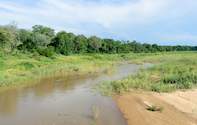
What Will Happen in Kruger's Rivers?
In 1988, the department of water affairs and forestry (Dwaf) completed an assessment of various options to improve the management of water available for social and economic development in the Groot Letaba catchment, which falls within the Luvubu-Letaba water management area.
The outcome of these investigations and other follow-up studies conducted in 2006, lead to recommendations that the construction of a new major dam at Nwamitwa in the Great Letaba River be considered, as well as the raising of the Tzaneen dam.
The new dam, which will take about five years to construct, is proposed at a site downstream of the confluence of the Nwanedzi river. The proposed concrete dam wall could be 36 metres high. “With a storage capacity of 144 million cubic metres the dam would increase the system yield by about 47 million cubic metres per year.
By comparison, the capacity of the Tzaneen dam is 157,5 million cubic metres,” according to the Great Letaba River Water Development Project (GleWaP) information leaflet. The catchment area of the proposed Nwamitwa dam is 1 400 km2 and the mean annual runoff is approximately 122,6 million cubic metres under undeveloped conditions.
The department aims to start delivering water from the new dam by 2012, and achieve a full yield by 2013. The project will involve the realignment of roads, such as the R529 between Tzaneen and Phalaborwa. It will also entail the construction of water pump stations and bulk water pipelines from the dam to supply domestic, industrial and agricultural users in the area.
Another option that is being investigated includes the raising of the Tzaneen Dam wall to approximately 203 million cubic metres, which would increase its firm yield by six percent. According to the background document, funding sources for the GleWaP are likely to include a public and private sector component. The construction cost of the infrastructure components of the project is estimated to be in excess of R1 500 million.
In the past, the Luvuvhu River has been found to be the cleanest in Kruger. As with all of Kruger’s rivers, the Luvuvhu and Letaba rivers have suffered in the past from overuse of their resources outside of the park, leading to extremely low flows in the park when users upstream increase their water extraction. As the flows decrease in the park, the pollutant concentrations often rise to the detriment of the river’s ecology.
Dwaf has embarked on an environmental impact assessment process and invited interested and affected parties to register as such, while also engaging stakeholders in a public participation process to discuss the proposed dam.
For more information contact Anelle Odendaal at 011 254 4855 or e-mail at aodendaal@zitholele.co.za.

 In the Kruger National Park there are five major rivers that historically flowed all year round – the Crocodile, the Sabie, the Olifants R...
In the Kruger National Park there are five major rivers that historically flowed all year round – the Crocodile, the Sabie, the Olifants R...